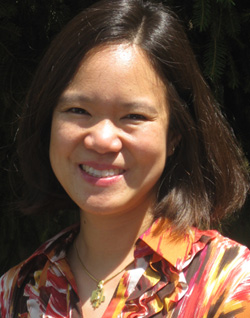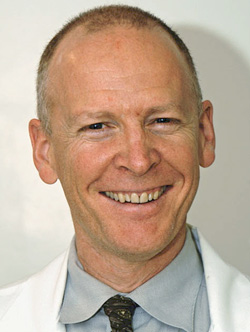

Healthy Dialogue
A Story of Stories: Pulse Offers a Weekly Spotlight on the Personal Side of Medicine
The best words to describe Pulse: Voices from the Heart of Medicine may come from its own writers, whose stories and poems are delivered to the electronic publication’s 10,000 subscribers each Friday.
“For me, Pulse was transformative,” said Dr. Tricia Pil, a Pittsburgh-area pediatrician whose true story “Babel: The Voices of a Medical Trauma” appeared in 2010. “Pulse turned my career and my life around.”

Paul Gross, M.D. with his wife Diane Guernsey, co-founders and editors of Pulse: voices from the heart of medicine.Since its founding in 2008 by Dr. Paul Gross, assistant professor of family and social medicine, the publication has carried works of nonfiction and poetry about medicine and healthcare—written by physicians, nurses, students, patients and others who experience it. In October 2013, the editors added haiku and visual images, which appear on alternating weeks.
Dr. Pil’s story?one of Pulse’s most widely read pieces?described a series of medical errors that occurred in 2005 as she was giving birth to her third child.
A combination of mistakes, expired medication, insensitive clinicians and other factors nearly killed her and her new son. The experience left Dr. Pil battling symptoms of post-traumatic stress disorder. She felt angry at the healthcare system she felt had abandoned her and skeptical about the profession she had chosen.
“After that, everything in my life was turned on its head,” she said.
Storied Success
Writing was a form of therapy, “a way of finding solace and connection,” she recalled. She gave up her clinical practice, returned to college and earned a degree in English literature. She began working as a writer and considered a career in teaching.
Still, she struggled with the trauma of her son Eric’s birth. How could she reconcile the conflict between her experience as a patient, her perspective as a physician and the accounts of the event by the hospital that treated her?
“It was like trying to put the pieces of a puzzle together,” Dr. Pil said. Finally, she gave up trying to make the pieces fit. Over the course of a single evening, she wrote a detailed, minute-by-minute log of what had occurred, supplemented by the notes of the clinicians on duty and subsequent words of explanation from hospital administrators.
The grim, matter-of-fact narrative, told in three distinct voices, became “Babel,” a riveting account of healthcare gone awry.
Giving Voices a Forum

Tricia Pil, M.D., a contributor to Pulse.Dr. Pil eventually returned to medicine, but drew on her experience to launch a new career working to prevent experiences like hers from being repeated. Today, she serves as medical director of quality and safety for a large network of pediatrics practices.
She credits Dr. Gross and Pulse with making that change possible.
“I had submitted the story to other medical journals and had a file cabinet full of rejection letters,” she recalled. “But when I sent ‘Babel’ to Pulse, I heard from Paul within just a few days. What struck me immediately was that he seemed to genuinely care about my story.”
She added, “Pulse was willing to go beyond the surface, to look at what medicine means to real people, even if that meaning is something dark. I believe Paul and the others who produce Pulse are healers—healers of our medical system.”
Dr. Gross, the publication’s editor-in-chief, is modest about his role in making Pulse beat.
“We’re fortunate to have wonderful contributors, many of whom have never written seriously before. But they have important stories to tell, stories that need to be heard,” he said. He also credits the consistently high quality of Pulse stories to his wife, Diane Guernsey, a former editor at Town & Country magazine, who serves as the publication’s executive editor.
Melding Muse with Compassion
Just as “Babel” resulted from Dr. Pil’s own experience, the story of Pulse is a personal one for Dr. Gross.
“In some ways, it’s about why I went into medicine,” he said, “which was in part a search for truth. What’s the truth of a clinical situation? It’s more than a diseased organ. It’s a whole patient and a human dynamic, which includes the clinician. How do you capture that?
“There are many, many medical journals, but that side of healthcare is often crowded out.”
As a young physician, Dr. Gross recalled, he had to learn to deal with his own emotions about the care he provided patients.
“Doctors are human beings,” he said. “I hope that when physicians read Pulse, they’ll say, ‘Ah, someone else has been there, too,’ and find it affirming.”
Dr. Gross isn’t the only one who appreciates the value of storytelling in the healing process. Recent years have seen a growing interest in “narrative medicine”—the use of writing and dialogue to better understand the experience of the patient, and to encourage creative thought by the clinician.
The Write Cure
Another champion of narrative medicine is Dr. Peter Selwyn, professor and chair of family and social medicine at Einstein and Montefiore Medical Center, and director of the office of community health at Montefiore.

Peter Selwyn, M.D., chair of family and social medicine, provided initial support for establishing the online publication.Dr. Selwyn participated in the some of the earliest studies of HIV/AIDS during the early 1980s, a time when the disease often amounted to a death sentence. He wrote about his own difficult experiences of this era in a 1998 book, Surviving the Fall: The Personal Journey of an AIDS Doctor, which was nominated for a National Book Award.
“I had read Peter’s memoir and was very moved by it,” said Dr. Gross. “So, it was fortunate that I could bring the idea for Pulse to him, knowing he was highly attuned to the role of stories in the care of patients.”
Dr. Selwyn’s department provided the initial support to launch Pulse, and he explained its role this way: “In medicine, writing can be healing in itself. It allows us to make sense of an experience, to share that experience and to understand ourselves and our patients. It’s a way to honor those other lives, to connect with their humanity and our own. Pulse provides a place for this to happen.”
“When doctors are perceived as being unfeeling, it’s not that they have no feelings,” added Dr. Gross. “It’s that they’ve learned to bury those feelings that are hard to face. Reflective writing serves as an antidote to that impulse—it helps medical students and residents stay in touch with their best selves.”
He continued, “I was lucky to be working at Einstein, whose leadership recognized the power of narratives in the training of young doctors and was introducing more reflective writing throughout the curriculum to teach professionalism and humanism.”
The support provided by Einstein and Dr. Selwyn—together with an advisory group of physicians and educators around the country—was critical in helping a good idea evolve into a publication that soon drew national attention and became a go-to resource for medical faculty.
“Pulse stories and poems are used in medical student and residency education because of their authenticity, honesty and immediacy,” noted Ms. Guernsey. “We encourage our writers to dig below the surface—to reveal their inner journeys in the midst of challenging situations.”
Creating Opportunities for Dialogue
Pulse appeals to a broader audience than physicians, however. “Babel” spawned a short documentary film freely available on YouTube, which has been viewed more than 2,000 times and has been used in medical ethics classes across the country. Two anthologies of works from Pulse have been published as well. And Pulse stories are picked up regularly by the Washington Post and the well-known medical blog KevinMD.
Perhaps the secret to the publication’s success is explained by Ms. Guernsey, who noted, “It helps that our format is accessible, and that our stories are short, five-minute reads. But the most important thing, I like to think, is that what we’re telling is genuine.”
In summing up her thoughts on Pulse, she added, “All of us have had to deal with health and medicine, in some way or form. That experience is universal, and each of us has a story to tell.”
Editor’s Note: Readers are invited to submit their own first-person stories to Pulse at Pulsevoices.org. Stories are generally about 1,000 words; for a full description of the submission guidelines, please visit the Pulse website. Pulse accepts haiku and other poetry submissions every autumn. Submissions of visual images are welcome year-round. This fall, Pulse plans to launch a More Voices section that will publish brief reader narratives on specific themes; these topics will be announced shortly.
Posted on: Friday, October 2, 2015

Tablet Blog